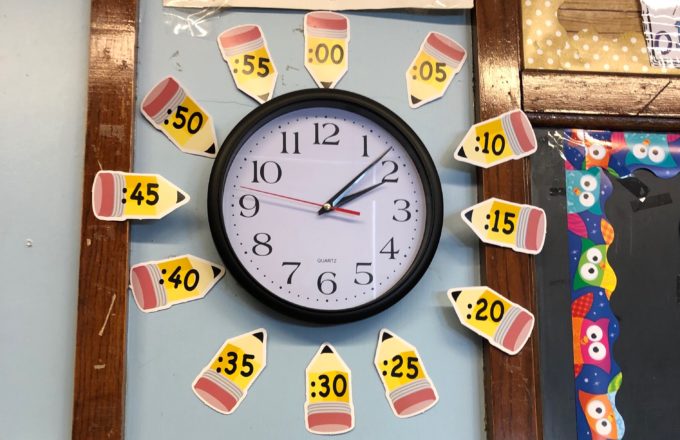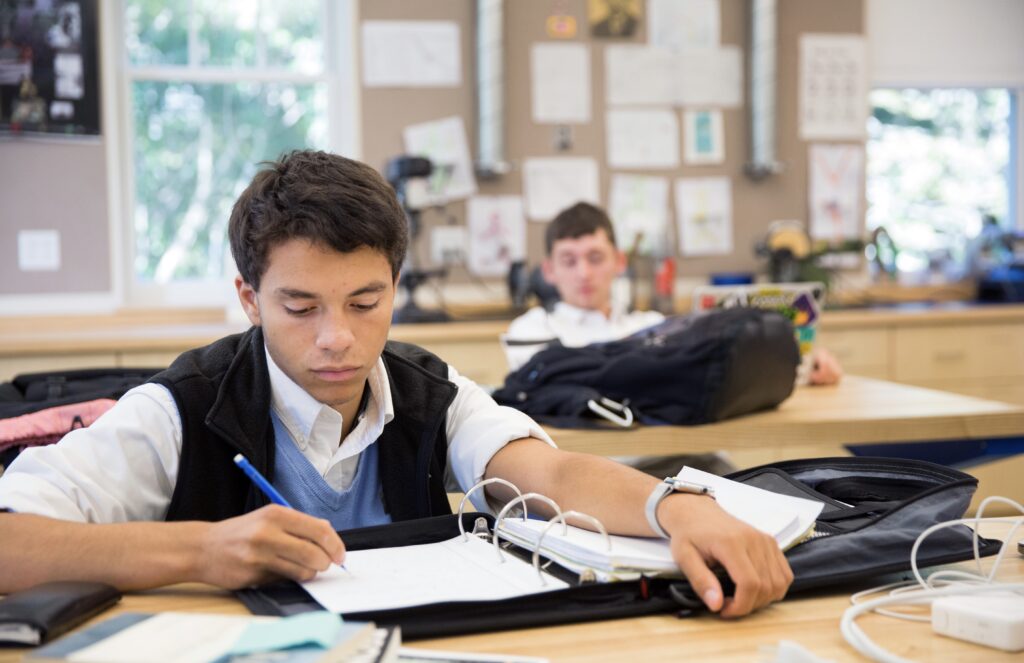This post is part of a series about helping students with LBLD experience academic success.
Read Lauren’s other blog posts:
Another big take away that I have learned and been able to implement into my substantially separate second grade language-based classroom is the importance of explicitly teaching time management skills.
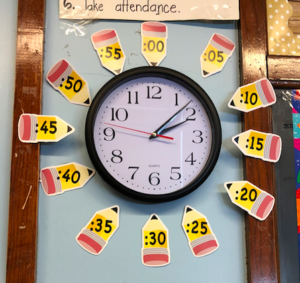 Many students can learn to tell time accurately at this young age, but the actual concept of the passage of time is a very challenging one. Let’s be honest, time management is hard for many people, myself included at times, and it plays a huge role in our everyday lives. After working with Landmark Outreach, I have learned that time management is a skill that students need to have modeled and explicitly taught. Students with language-based learning disabilities, ADHD, or difficulties with executive functioning need these supports more than most to help them be successful both in and out of the classroom.
Many students can learn to tell time accurately at this young age, but the actual concept of the passage of time is a very challenging one. Let’s be honest, time management is hard for many people, myself included at times, and it plays a huge role in our everyday lives. After working with Landmark Outreach, I have learned that time management is a skill that students need to have modeled and explicitly taught. Students with language-based learning disabilities, ADHD, or difficulties with executive functioning need these supports more than most to help them be successful both in and out of the classroom.
Some benefits of modeling and explicitly breaking down a task with my students are:
- Students have a better awareness of where we are during the school day and what subjects we have left. It helps reduce the anxiety or feelings of being overwhelmed with the demands of a whole school day.
- Time on task has increased, and the ability for students to initiate a task has improved with the use of timers.
- Students have been able to deal with change and uncertainty, as well as approach the day with more flexible thinking. Also, it has helped them feel more at ease in the ever-changing elementary classroom.
- Students have been able to understand how long a task will take, which has helped them to feel proud of their accomplishments.
There are some components that I have always had as part of my classroom routine, but it wasn’t until I made some small adjustments that I have seen huge changes in the way in which the students work throughout the school day.
Use a class schedule
Yes, I’ve always had a schedule up in my classroom so the students are aware of what is happening in their day. Of course we need to post the class schedule and make it visual, but it wasn’t until I made it more interactive that my students relied on it and felt good about moving throughout their school day. I have made improvements to it over tie, and now the students use the bright yellow arrow on a magnet and actively move it down as we complete a subject. Managing the schedule typically turns into a student job for the week. Not only does it help me stay on schedule, it really helps all learners understand the passage of the school day, what we have finished, and how much we have left to do. I love hearing, “We have one more thing to get done before we go to lunch,” or “Wow, the day went by so fast, how are we already at our last subject for the day?”
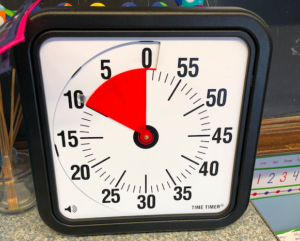 Use a timer
Use a timer
I love timers! I can’t stress this enough. There are so many options for timing activities, from sand timers and kitchen timers, to battery operated visual and audio timers, to technology based timers that you can use on your interactive whiteboard, and even apps for a tablet or smartphone. I typically use timers to help students become aware of the passage of time. I will tell my class that we will be working on writing for the next 20 minutes and then we will be done. I set the timer and we are off and running. I make sure I interrupt them to explain that we are half-way through, and again with 5 minutes left. When the timer goes off, I announce that it’s time for pencils down. By explicitly announcing the time during a task, students are being taught the passage of time. If you walk by my classroom, you will not only see these various timers in use but you can always hear me counting down from 10 to help with transitions to announce the end of one thing and indicate that we are moving on to another.
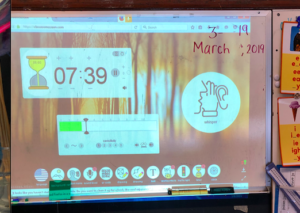 When it comes to time on task, in the past I have noticed that students have had trouble initiating a task. I have also had some students with ADHD who struggle to sit still to even complete a short writing task. However, after introducing the timer approach, it is amazing to see all students want to get to work right away. They know a break is coming and that their task will soon be over. I am always mindful to start small and build stamina for all tasks. It is important to always be aware if setting a timer could cause some
When it comes to time on task, in the past I have noticed that students have had trouble initiating a task. I have also had some students with ADHD who struggle to sit still to even complete a short writing task. However, after introducing the timer approach, it is amazing to see all students want to get to work right away. They know a break is coming and that their task will soon be over. I am always mindful to start small and build stamina for all tasks. It is important to always be aware if setting a timer could cause some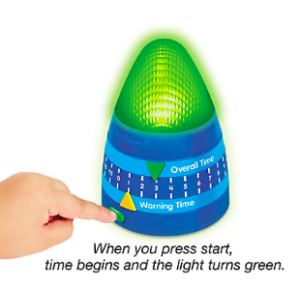 stress for a child with weak processing speed, but at this young age, I have seen positive outcomes for all students and have noted their feelings of accomplishment when time is up.
stress for a child with weak processing speed, but at this young age, I have seen positive outcomes for all students and have noted their feelings of accomplishment when time is up.
(My all time favorite timer is the Light Up Countdown Timer from Lakeshore)
Short term and long term assignments
I talked a bit in my last post about how my students organize their materials with their B.E.E binder, and in their home/school binder they keep an agenda book. The agenda books are a great tool that we use for organizing and writing down nightly homework. But these only work if I set specific time aside to assign the homework, have the students copy it down, and preview the assignment to help our students if they have any questions. I want all of my students to become independent with completing their homework. The agenda books are a great way to teach a student to look at the daily tasks that need to be completed.
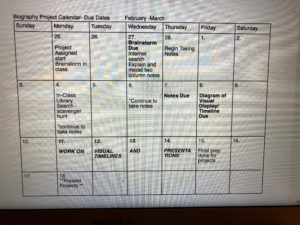 I use calendars for myself and the students to help with understanding long term assignments and due dates. It is important that we take the time to teach the process of planning long-term assignments, instead of just simply assigning a project and giving it a due date. The more clear and explicit I can be, the better my students keep track of what they are responsible for completing. They then put these calendars in their binders and together we check off and cross out the things they have completed. This process helps students to know that they don’t have a giant project looming over their heads, but rather smaller tasks that lead to progress towards the end goal.
I use calendars for myself and the students to help with understanding long term assignments and due dates. It is important that we take the time to teach the process of planning long-term assignments, instead of just simply assigning a project and giving it a due date. The more clear and explicit I can be, the better my students keep track of what they are responsible for completing. They then put these calendars in their binders and together we check off and cross out the things they have completed. This process helps students to know that they don’t have a giant project looming over their heads, but rather smaller tasks that lead to progress towards the end goal.
By taking the time to explicitly teach time management in our classrooms, we will see positive changes with our students. It will help all learners improve their time on task and be more efficient with their time throughout the day. Also, the students will feel less overwhelmed and more proud of their accomplishments, and they will be more willing to attempt tasks that they might initially perceive as difficult.
